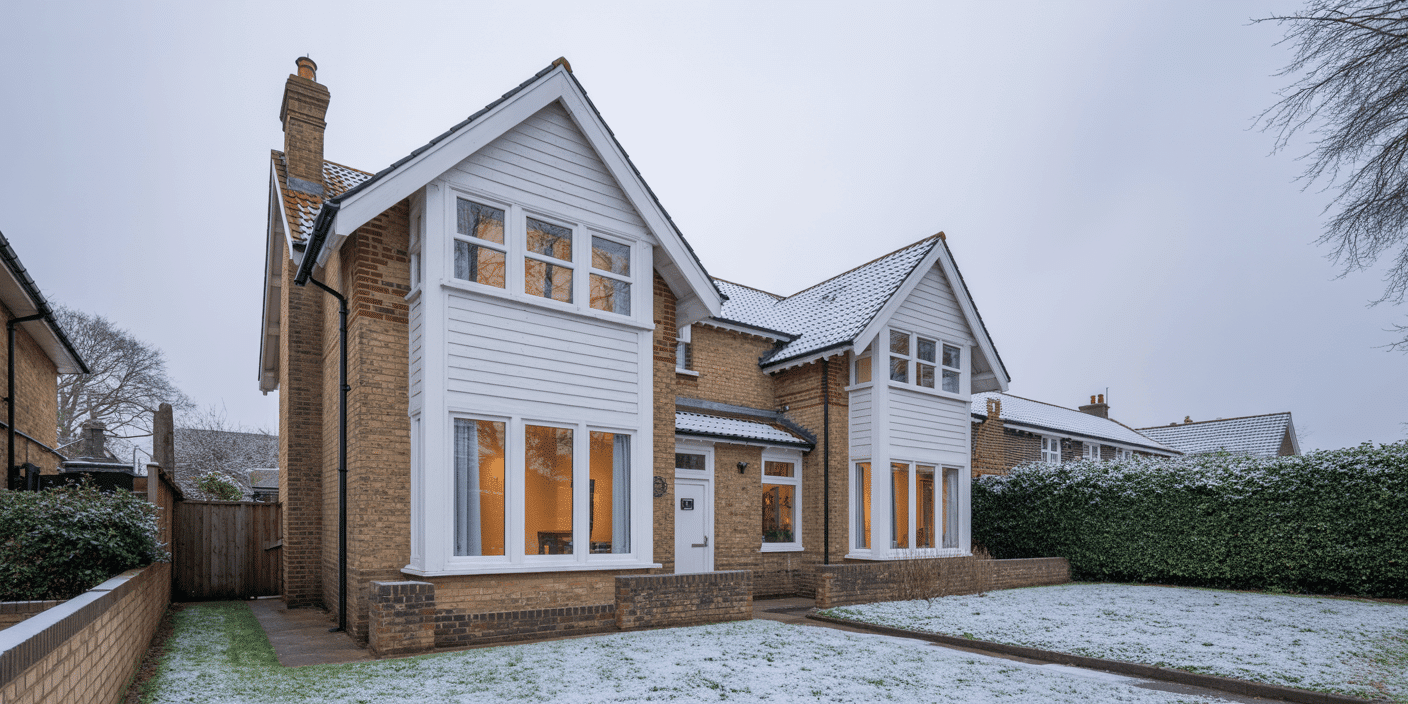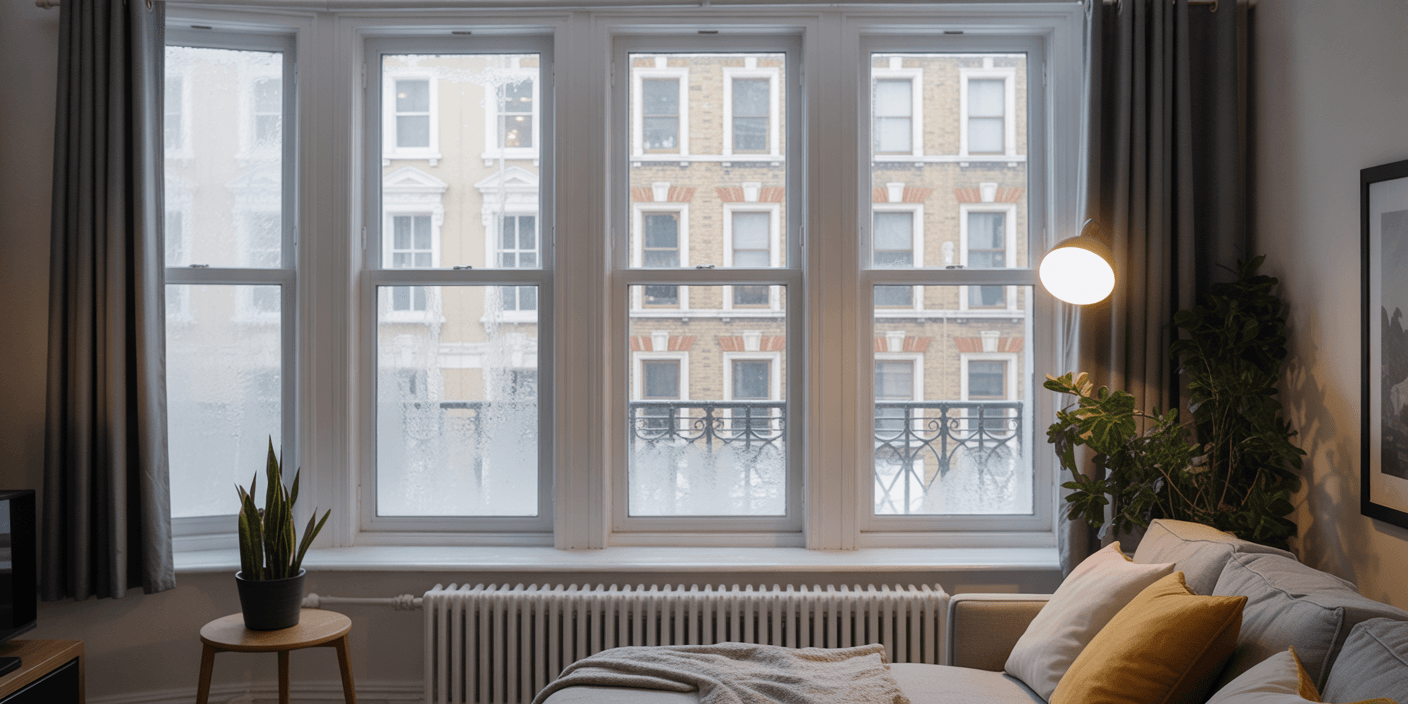The U-Value: The Quiet Metric Costing Homeowners Thousands
Every winter, British homes lose a significant portion of their heating through a single architectural weakness: inefficient glazing.
This is not the result of oversight or poor maintenance — it’s the result of a performance metric most homeowners are never told to ask about.
That metric is the U-value.
It doesn’t appear on your energy bill, yet it determines how high that bill climbs.
It’s printed on window specifications, though rarely questioned.
And it is often the defining factor between a home that maintains its warmth and one that silently haemorrhages it.
An Unseen Drain on Comfort and Capital
Heat loss is not always felt as a draught or seen as condensation.
It often occurs invisibly — through the glazing, the frame, and the junctions where craftsmanship meets engineering.
Loft insulation may be installed. Walls may be upgraded. But if the windows underperform, thermal efficiency collapses at the perimeter.
In technical terms, the U-value is a measure of thermal transmittance — how quickly heat passes through a material.
In practical terms, it determines how much of your comfort and heating spend you retain — and how much you surrender to the elements.
The Cost of Inefficiency
Single-glazed sash windows, still present in many period homes, typically exhibit U-values around 5.0 W/m²K — a level of performance that is no longer fit for purpose.
Modern double glazing reduces this to approximately 1.6, while best-in-class passive-rated systems achieve values below 1.0.
These differences may appear marginal.
They are not.
Reducing from 1.6 to 1.0 can cut a home’s heat loss by up to 30%.
On a £2,000 annual heating bill, that equates to savings in the region of £400–£600 every year, indefinitely.
Why This Number is Often Ignored
Homeowners are typically offered decisions based on aesthetic variables: timber finish, sightlines, ironmongery, and glazing bars.
But the most consequential choice is rarely discussed — the energy performance of the unit as a system.
The true U-value is not defined by the glass alone. It’s the combined performance of the glass, frame, spacer, and seals.
Without these working in concert, any thermal claim is incomplete.
At Sash Windows London, this performance metric is not a technical afterthought.
It is the starting point of every design specification.
Because thermal comfort, compliance, and cost-efficiency are not optional outcomes. They are engineered in from the outset.
The Principle
You cannot see a U-value.
But you will feel its consequences — in your comfort, in your heating costs, and in your home’s future compliance with tightening energy regulations.
Once understood, it reframes the entire window conversation.
Not as a matter of aesthetics alone, but as a critical architectural decision — one that affects every room, every season, every bill.
The Science Simplified: What U‑Values Actually Measure
Most people hear the term “U‑value” and assume it’s something for engineers or building inspectors.
But it’s simpler than it sounds.
A U‑value measures how easily heat escapes through a material — or, more precisely, how many watts of energy pass through every square metre of it for each degree of temperature difference between inside and out.
That sounds abstract.
So, let’s put it in human language:
A window with a high U‑value leaks heat fast.
A window with a low U‑value keeps warmth in.
It’s as straightforward as that.
Think of it as the golf score of energy performance — the lower, the better.
A Quick Reality Check
| Type of Glazing | Typical U‑Value (W/m²K) | Thermal Performance |
| Old single glazing | ~ 5.0 | Loses heat rapidly |
| 1990s double glazing | ~ 2.8 | Moderate improvement |
| Modern double glazing | ~ 1.4 – 1.6 | Current UK Building Regulations (Part L) |
| Triple glazing | ~ 0.8 – 1.0 | High performance |
| Passive‑house standard | ≤ 0.6 | Exceptional insulation |
That’s not just a table of numbers — it’s a timeline of progress.
Each decimal shaved off represents real energy saved, carbon reduced, and comfort gained.
Whole‑Window, Not Just Glass
Many homeowners are shown the centre‑pane U‑value — the figure that applies to the glass alone.
It’s flattering, but misleading.
Heat also travels through the frame, the spacers, and even the sealant.
That’s why professionals talk about the whole‑window U‑value: the combined performance of everything from sash to sill.
At Sash Windows London, every specification lists the true, whole‑window figure.
No fine print, no selective data — just the honest number that matters in real homes.
Because compliance isn’t a box to tick; it’s a standard to uphold.
Why It Matters
A home with low‑performing windows feels unpredictable: warm near the radiator, cold by the glass.
That imbalance forces boilers to run longer, rooms to fluctuate, and costs to rise.
By contrast, a low U‑value window keeps heat where you’ve paid to create it — consistent, quiet, and controlled.
It’s not just an engineering metric.
It’s the foundation of thermal comfort.
The Bridge to What Comes Next
Now that we understand what the U‑value measures, the next question is simple: how does it affect your bills in practice?
That’s where the science meets your wallet — and where the difference between a typical window and a high‑performance one can be hundreds of pounds a year.
The Real-World Cost: Heat Loss and Your Heating Bill

Most people don’t walk into a window showroom asking for a lower U-value.
They say things like:
“The room’s always cold in the morning.”
“There’s mould on the bottom of the curtains.”
“The bills just keep going up.”
And yet, in almost every case, the cause — and the cure — lies in how efficiently their windows manage heat.
Because when your windows leak warmth, your wallet bleeds quietly with them.
How Heat Escapes — And How Fast
Let’s say it’s 20°C inside your sitting room, and 5°C outside — a typical British winter day.
If your glazing has a U-value of 5.0 (as single glazing often does), you’re losing heat five times faster than someone with a window rated at 1.0.
That’s not theory. That’s maths.
And that heat must be replaced by your boiler, which burns more gas, uses more energy, and costs you more money every time it switches on.
A Quiet Financial Leak: By the Numbers
Let’s look at the average period home in London with 15 windows.
- Single-glazed sashes might leak £700–£900/year in excess heating costs.
- Standard double-glazing trims that down, but still wastes £250–£400/year.
- High-performance low U-value systems can cut heating loss by up to 60% — delivering savings that stack year after year.
Add it up over 10 years, and you’re not comparing windows.
You’re comparing whether you’d like £4,000–£6,000 back in your pocket — or out through your glazing.
Cold Glass Feels More Expensive
It’s not just the bills.
It’s the feeling.
- The cold patch by the French doors.
- The draught you can’t find but always feel.
- The condensation that creeps down the panes in February.
These are symptoms of a high U-value.
And the worst part? Most people assume it’s normal.
At Sash Windows London, we hear the same story time and time again:
“We thought the whole house just felt cold.”
“We didn’t realise how much warmer it could be until after the install.”
The Hidden Return on Investment
Low U-value windows cost more upfront — there’s no point pretending otherwise.
But what they offer is not just savings. It’s certainty.
- Certainty that every room feels comfortable at the same time.
- Certainty that you’ll pass compliance checks in future upgrades.
- Certainty that your energy spend goes further, every single month.
In many homes, our systems pay for themselves in under 5 years, depending on glazing type and energy use.
And after that? They keep paying you back — in savings, silence, and warmth.
What Comes Next
The natural question is: how do you actually achieve low U-values in modern windows — especially when the style matters as much as the performance?
That’s where materials, glazing layers, and installation quality step into the story — and where the difference between “tick-box compliance” and “engineered comfort” becomes clear.
How Modern Windows Achieve Low U-Values
— And Why Most Don’t Go Far Enough
A window may look traditional on the outside, but its performance is governed by what’s hidden beneath the paint.
Glass is only part of the equation.
To achieve genuinely low U-values — the kind that reduce heating bills and satisfy future regulations — every component must do its part.
At Sash Windows London, that process starts at the molecular level.
Because thermal performance is not a feature, it’s a system.
1. Low-E Glass: Invisible But Essential
Most people think of glass as neutral — something you look through, not think about.
But modern Low-Emissivity (Low-E) coatings turn ordinary glass into a thermal barrier.
- A microscopically thin layer of metal oxide is applied to the inner face of the glazing unit.
- It reflects radiant heat back into the room while still letting in natural light.
- The result: warmth stays inside, and cold stays out — even when the glass feels cool to the touch.
This is non-negotiable for any window claiming low U-values.
2. Gas Fills: Slowing the Invisible Escape
Between the panes of a double or triple-glazed unit is a sealed cavity.
Most assume it’s just air.
In reality, it’s often Argon or Krypton — inert gases that conduct heat far more slowly than air.
These gases slow down the movement of thermal energy from one pane to the other.
Used correctly, they reduce U-values by up to 30% over air-filled alternatives.
“Warmth doesn’t rush. It’s held in place by physics.”
3. Spacer Bars: The Silent Weak Spot
Even in well-made double glazing, the edge of the glass unit can betray the whole system.
Why? Because metal spacer bars — traditionally aluminium — conduct heat rapidly, creating what’s known as a “cold bridge”.
Warm-edge spacer technology replaces these with composite or insulated materials that match the performance of the glazing unit itself.
It’s a small detail. But in thermal terms, it’s the difference between theory and reality.
4. Thermally-Broken Frames: Where Most Systems Fail
A high-performance glazing unit means nothing if it’s mounted in a heat-leaking frame.
This is where thermally broken or composite frames come in — systems that interrupt thermal pathways within the frame itself.
At Sash Windows London, we offer:
- Engineered timber frames with natural insulating properties
- Alu-clad options with composite cores for modern builds
- Sash window designs that maintain traditional sightlines while exceeding Part L standards
The frame is no longer just the bit that holds the glass.
It’s part of the thermal envelope.
5. Installation: The Final Decider
Even the best-engineered window fails if fitted poorly.
Gaps, poor sealing, thermal bridging at the junctions — these are the hidden killers of performance.
Our fitters work to tolerances tighter than regulation demands.
- Foamed insulation at perimeter edges
- Concealed membranes for air and moisture control
- Precision sealing that lasts decades, not just months
“A window’s U-value is only as good as the hands that install it.”
Bringing It All Together
Low U-values aren’t achieved through a single trick.
They’re the result of layered systems, engineered alignment, and disciplined quality control.
And they’re precisely what distinguish a decorative window from one that actually performs.
In the next section, we’ll explore how these invisible upgrades show up in your everyday life — in comfort, quiet, and certainty — long after the paperwork is filed.
Regulations & Responsibility: Part L and the Future of Compliance
— Why What’s Legally Required Isn’t Good Enough
When it comes to windows, U-values aren’t just technical preferences.
They’re legal thresholds — embedded into the very fabric of British building regulations.
And like most legislation, the bar is rising.
The current regulation is called Part L — the section of the Building Regulations that governs energy efficiency in buildings. It sets out what’s legally required of window performance, particularly regarding how much heat your windows are allowed to lose.
But here’s the problem:
Part L is the minimum. Not the optimum.
What the Law Actually Says
As of the latest update:
- Replacement windows must achieve a whole-window U-value of 1.6 W/m²K or better
- In some cases, Window Energy Ratings (WER) of B or above are accepted as alternatives
- New-build and extension requirements are stricter still — often 1.4 W/m²K or below
These numbers are non-negotiable.
Install windows that don’t comply, and:
- Your project could fail the sign-off
- Your property could be non-compliant for resale or letting
- Your investment could be compromised before it’s even warmed the room
Why These Standards Are Getting Tougher
The UK government has a target: Net Zero carbon emissions by 2050.
Buildings account for nearly 40% of the nation’s energy use, and windows are among the biggest culprits of heat loss.
To meet these targets, the government must steadily raise the standard of thermal efficiency across every home, flat, and extension.
That means:
- Tighter U-value limits every few years
- More scrutiny on real-world performance (not just lab results)
- Stronger expectations for whole-window values instead of best-case numbers
And if your windows don’t already exceed the minimum, you may find yourself replacing them again — sooner than expected.
Heritage Homes Are Not Exempt — Just Misunderstood
If your property sits within a conservation area or is listed, you may assume regulations don’t apply.
That’s not quite true.
While certain aesthetic exemptions exist, Part L still applies as far as “reasonably practicable”.
Which means:
✅ If you can retain the style and improve performance, you’re expected to
✅ If low-U-value alternatives exist that match the heritage look, planners favour them
✅ If your supplier offers compliant systems that meet traditional sightlines, you’re held to that standard
Sash Windows London specialises in this very territory:
- Conservation-friendly solutions that satisfy both planners and engineers
- Whole-window certification that meets Part L and retains heritage appearance
- Long-standing relationships with local authorities and conservation officers
We don’t treat compliance as a hurdle.
We treat it as a design constraint — one we’ve already solved for.
The Future is Lower Than You Think
Many high street window suppliers quote “compliant” double glazing at 1.6 W/m²K — the current floor.
But the next revision of Part L is expected to lower that to 1.2 or even 1.0.
If your current install just scrapes over the line, you may be:
- Paying more to heat an underperforming home
- Facing early obsolescence as standards tighten
- Leaving value on the table when reselling or refinancing
By contrast, our high-performance systems are already operating at 0.8–1.2 W/m²K, depending on configuration.
That’s not just compliant.
That’s future-proof.
What This Means for You
Choosing windows with poor U-values isn’t just a comfort risk — it’s a compliance liability.
And as regulations accelerate towards higher standards, every poor-performing window becomes a sunk cost.
With Sash Windows London, compliance isn’t something we scramble to meet.
It’s something we build into every detail — so you can move forward with confidence, not caveats.
Comfort, Quiet and Confidence: The Human Benefits of Low U‑Values

— Because It’s Not Just What You Save. It’s What You Feel.
Numbers don’t live in homes — people do.
And while U-values drive heating bills and satisfy building inspectors, their real impact is felt quietly, every day.
- In the bedroom that stays warm overnight.
- In the hallway where the draught disappears.
- In the living room that no longer echoes with passing traffic.
Low U-value windows don’t just meet regulations — they change how your home behaves.
And once you’ve lived with them, you won’t go back.
1. Even, Predictable Warmth
In older properties — especially period sash window homes — temperature varies wildly from one room to another.
The culprit? High U-values.
With modern, thermally efficient glazing:
- Heat is retained longer, reducing reliance on radiators
- Cold spots vanish, even near large panes or bays
- Thermostats stabilise, saving fuel and frustration
It’s not just warmer.
It’s consistently warm — without the drama of peaks and drops.
2. Draught-Free, Whisper-Quiet Rooms
Warmth is one half of comfort.
Stillness is the other.
Poor-performing windows let in more than cold.
They transmit sound — wind, neighbours, engines, sirens — straight into your living space.
Our low U-value systems, especially double or triple glazing:
- Cut down external noise dramatically, even in urban zones
- Eliminate draughts, thanks to airtight seals and multi-chamber frames
- Offer stillness that’s felt, not just heard
The result?
A home that rests with you. Not against you.
3. No More Condensation, No More Mould
Windows are the most common site of interior condensation.
This isn’t just inconvenient — it’s unhealthy.
Condensation forms when warm, moist air hits a cold surface.
High U-value glass and frames act as cold spots, triggering moisture, then black mould.
Low U-value systems:
- Keep inner surfaces warmer, reducing condensation risk
- Preserve the integrity of timber sills and plaster reveals
- Improve indoor air quality, particularly for children and those with respiratory issues
Your windows should never be colder than the air around them.
4. Passive Performance = Active Peace of Mind
One of the most powerful — yet invisible — benefits of low U-value glazing is what it allows you to stop doing.
- Stop worrying if the heating’s been on too long
- Stop adjusting the thermostat for “that one cold room”
- Stop explaining to guests why it’s chilly near the windows
- Stop scheduling window wipes every morning in February
In short: stop managing discomfort. Start enjoying home.
5. Beauty Meets Function — Without Compromise
With Sash Windows London, performance doesn’t come at the expense of aesthetics.
Our clients are homeowners who care deeply about period character, but also demand modern comfort.
Whether it’s:
- Elegant Georgian proportions
- Slim Victorian sightlines
- Flush timber profiles with 21st-century internals
We craft performance invisibly — ensuring your windows do their job without ever looking like they’re trying to.
This Is the Real ROI
Return on investment isn’t just about kilowatts or pounds.
It’s about how your home feels to live in — in winter, in summer, in silence, in calm.
Low U-value windows don’t just save money.
They return comfort, preserve health, and deliver a quieter kind of luxury that never goes out of style.
The Proof: A London Home Transformed by Low U‑Value Windows
— A Quiet Revolution in Comfort, Compliance and Character
Mrs Thompson lives in a late Victorian terrace in Wandsworth.
Tall ceilings. Box bay windows. Charm by the metre.
And until recently, cold by the minute.
For years, she managed the quirks with extra throws, under-rug heaters, and oil-filled radiators.
She loved her home. But it never quite loved her back.
Every winter, she spent over £2,400 on heating — and still avoided sitting near the windows after 5pm.
“I thought it was just what you lived with in an older home,” she told us.
“We’d already replaced the boiler. We’d insulated the loft. But the front rooms were always cold.”
The Problem
- Original single-glazed sash windows with gaps wide enough to rattle
- Condensation builds up on panes every morning
- Sound bleed from the nearby road
- Mounting energy bills despite improved heating systems
It wasn’t aesthetics that needed changing — it was performance.
But the new windows couldn’t look new.
They had to match the heritage character exactly, while quietly delivering modern performance under the surface.
The Sash Windows London Solution
We conducted a full thermal audit of the home, using infrared thermography and U-value mapping.
Every original sash unit was replaced with bespoke, timber sash double-glazed windows — engineered to a whole-window U-value of 1.2 W/m²K.
Key upgrades included:
- Low-E coated double glazing
- Argon gas-filled sealed units
- Warm-edge spacer technology
- Multi-layer, engineered timber frames with concealed draught-sealing
- Exact-match Georgian bar profiles and horn detailing, preserving period character
Installation was completed in 5 days, including external and internal finishing.
The Results
Heating Bill Reduction:
- 34% drop in annual energy usage
- Projected savings: ~£820/year based on current tariffs
Improved Thermal Comfort:
- Bedroom and lounge temperatures remained 2.8°C warmer overnight
- No detectable draughts on thermal audit post-install
- Radiators used 22% less runtime over the 30-day measurement window
Noise Reduction:
- Road noise dropped by approximately. 50% (measured in dB)
- Bedrooms became noticeably quieter, even during morning traffic
Condensation Eliminated:
- Zero internal window condensation after 4 weeks of consistent 4°C outdoor temps
“The house is warmer, yes — but also calmer,” Mrs Thompson said.
“And we didn’t lose an inch of the original charm. You’d never guess the windows were new. Which is exactly the point.”
The ROI
- Payback period: 4.5 years based on energy savings
- Planning officer sign-off without objections (conservation area)
- Increased property value through energy performance uplift
- Zero disruption to façade or internal finishes
This is what happens when performance and preservation are given equal weight.
Sash Windows London doesn’t ask homeowners to choose between character and comfort.
We deliver both — invisibly.
Precision You Can Feel
— The Window Isn’t the Feature. The Comfort Is.
You don’t buy windows because you like glass.
You buy them because you want your home to feel warmer, quieter, and smarter to live in.
That’s what low U-value systems deliver.
Not with gimmicks or guesswork, but with proven engineering — built to last, built to comply, and built to perform in ways most people never notice… until they’ve lived without them.
Because that’s the beauty of thermal precision:
You don’t see it. You feel it.
In the calm of a bedroom that no longer shivers at dawn.
In the hush of a lounge that used to buzz with traffic.
In the satisfaction of a bill that finally makes sense.
And in the quiet pride of knowing your windows don’t just look right —
They are right.
If You’re Thinking of Replacing Your Windows, Start With the Number That Matters
Before you choose the colour, the handle, or the bar design — ask one thing:
What’s the whole-window U-value?
If the answer doesn’t begin with a 1 — or better, a 0 — you’re buying problems that haven’t arrived yet.
At Sash Windows London, we don’t treat U-values as footnotes.
We treat them as the foundation of everything: comfort, compliance, conservation, and common sense.
Ready to See (and Feel) the Difference?
If your windows are costing you comfort — or money — it’s time to find out just how much.
✅ Book a Free Thermal Survey
✅ Request a Compliant Specification Pack
✅ Or speak to one of our advisors about conservation-ready, low-U-value options — engineered for warmth, not guesswork.
Sash Windows London
Crafted to perform.
Designed to disappear.
Felt in every room.







